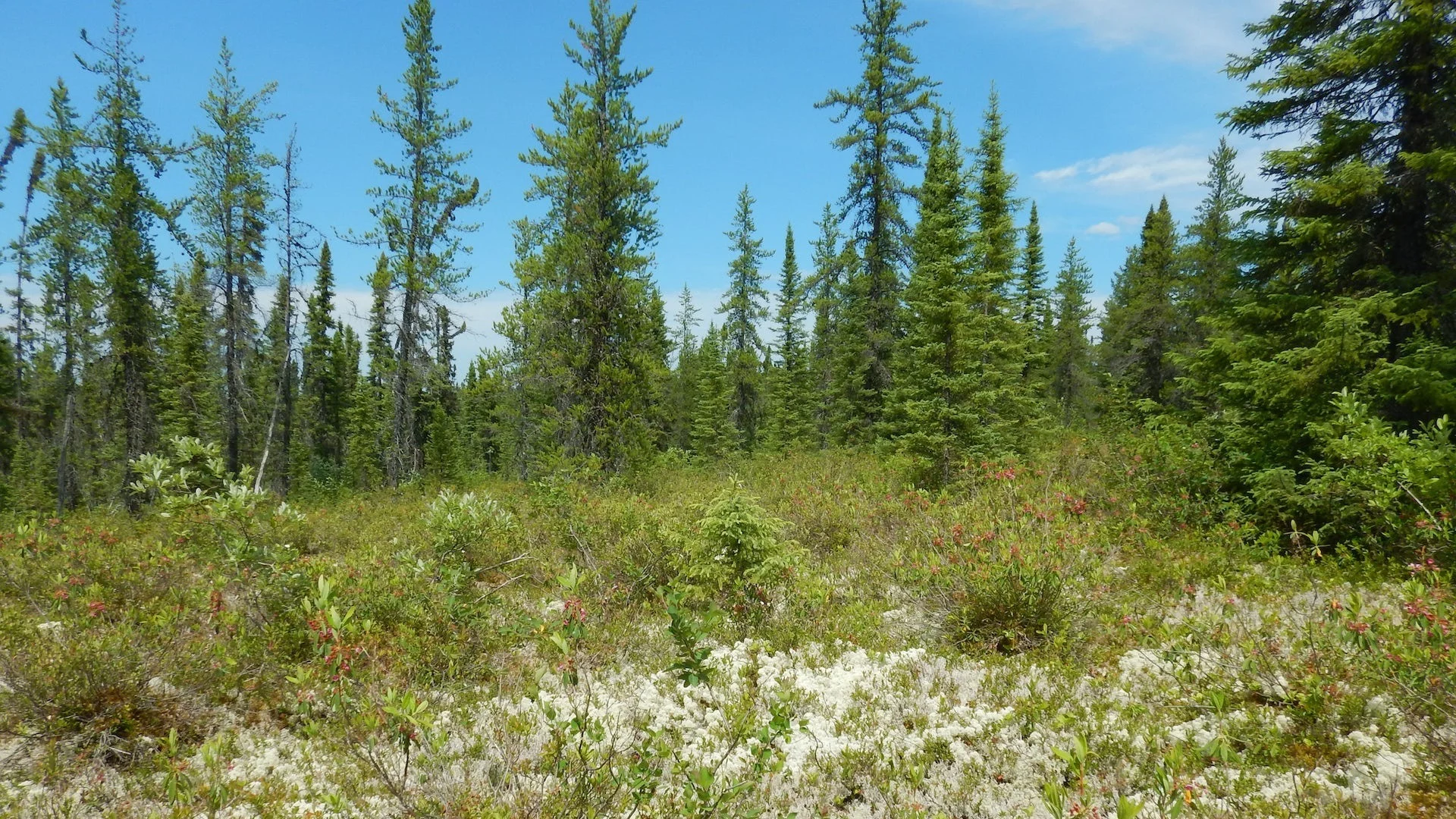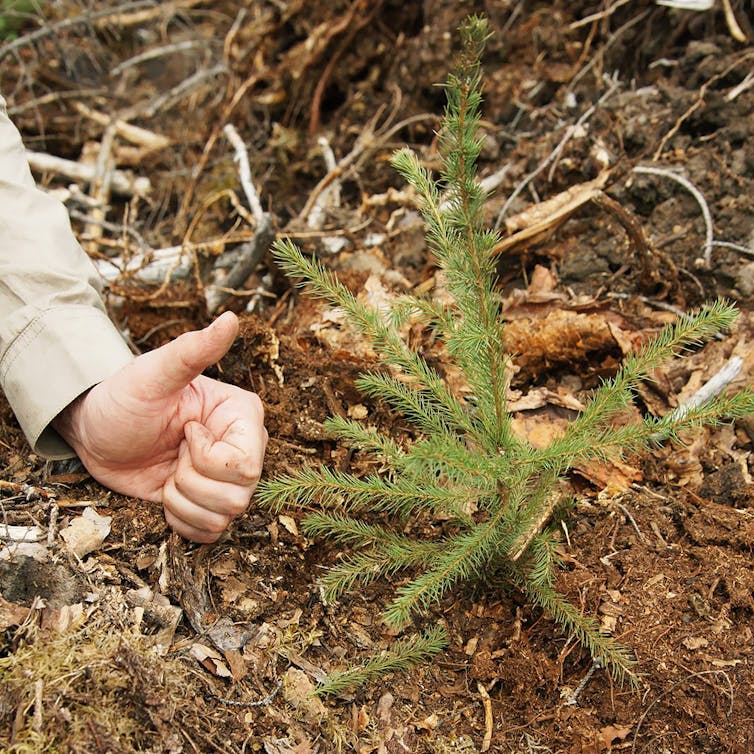
Can the boreal forest be used to concretely fight climate change?
La Conversation Canada invites you to take a virtual walk in the heart of the boreal forest. In this series, our experts focus on management and sustainable development issues, natural disturbances, the ecology of terrestrial wildlife and aquatic ecosystems, northern agriculture and the cultural and economic importance of the boreal forest for Indigenous peoples. We hope you have a pleasant — and informative — walk through the forest!
This article is part of La Conversation Canada’s series The boreal forest: A thousand secrets, a thousand dangers
CO2 emissions from fossil fuel use and deforestation are the causes of global climate warming exceeding 1°C over the past 100 years. At the current rate, this warming will most likely climb to 2°C before 2100, causing climate disruption around the world.
To address this threat, all means for reducing emissions and increasing global CO2 removals must be implemented rapidly and in a sustained manner. Towards that end, halting deforestation and significant afforestation are widely recognized as effective and inexpensive tools for combatting climate change, since trees capture CO2 and store it in the wood, roots and soil.
This is what prompted the Canadian government to include planting two billion trees between 2020 and 2030 on its list of actions to be taken to achieve carbon neutrality by 2050.
But is the solution really that simple? Can planting trees help us solve the climate crisis?
We are professor-researchers in the Sciences fondamentales Department at the Université du Québec à Chicoutimi (UQAC). We are working within the research infrastructure Carbone boréal carbon offset program to try to answer this question.
From global to local

Prospective studies on the evolution of forests in a context of climate change are based on models applied to plots of land larger than 100 square kilometres. This area is roughly the equivalent of half of the area of Québec’s Île d'Orléans, or a little less than a quarter of the island of Montréal.
But what happens on a smaller scale, depending on local characteristics and the tree species actually present in the stands? How will the trees react to the new climatic conditions? How will the forest disturbance regime evolve? What strategies can be recommended to make forests more resilient and better adapted to new climate conditions? What is the likelihood that the projected additional carbon stocks will be available in 2050? On what land can new trees be reasonably planted while avoiding land use conflicts?
These are the kinds of questions that motivated a team of UQAC researchers to launch the Carbone boréal project in 2008.
An original infrastructure
In the boreal forest, there are large areas (estimated to be 7 per cent of the exploitable boreal forest in Québec) that have low tree densities. This characteristic qualifies them as non-forests, according to the definition of the United Nations’ Food and Agriculture Organization (FAO).
These open areas, where more than three-quarters of the vegetation consists of lichens and Ericaceae, are the result of successive natural disturbances, such as forest fires or insect pests. Because of a lack of seeds and degraded soil conditions, these non-forests do not re-densify over time. Indeed, depending on the type of fire that burns on the surface or deep down, the organic matter of the soil will be preserved or completely burnt. That creates less favourable conditions for seeds to become established as seedlings.

This process of natural deforestation can be reversed through interventions such as scarification (shallow soil turning), either followed by tree planting, or not.
Carbone boréal is a research infrastructure that is unique in the world for its objectives, approach and funding. It was created using three hypotheses:
After 15 years of research and over 1.5 million trees planted and verified, these three hypotheses have been proven and the plantings carried out are beginning to answer new research questions.

Questions and answers
Field measurements taken in our plantations every five years have demonstrated an unexpected growth performance of jack pine and tamarack in the early years of growth, as well as a higher rate of carbon fixation than predicted by models.
We also demonstrated the importance of site selection in optimizing carbon sequestration and developed new equations to assess tree biomass using non-destructive measurements. Further work is underway to quantify soil carbon loss from scarification and net additional carbon accumulation over 20 years. Starting from the perspective of a circular economy, we are investigating the fertilization potential of industrial byproducts, such as paper mill biosolids, and the potential productivity and resilience gains of plantations with assortments of species.
Wacth below: Acadian forest at risk of losing biodiversity
A key concern raised by climate models is how afforestation in the boreal zone actually affects the climate. Although boreal forests absorb CO2 (which has a cooling effect on climate), they decrease the fraction of solar energy that is directly reflected back to space compared to open areas. This phenomenon could create local warming and reduce the overall climate benefit of the additional CO2 capture by the trees. But what is the real magnitude of this effect? Does it vary according to latitude, tree species and plantation age? Our team will tackle these questions in the winter of 2023.
In 2024, with more than two million trees planted in research facilities on public and private land, Carbone boréal will account for an area of 1,000 hectares (10 square kilometres, five times the size of Mount Royal Park in Montréal) dedicated to long-term research for UQAC. These trees will capture more than 4,000 tons of CO2 each year by 2030.
This is a concrete and original way to better understand the role of the boreal forest on climate change and to experiment with ways to adapt it to its new conditions.
Claude Villeneuve, Professeur titulaire Chaire en éco-conseil spécialiste des changements climatiques, Université du Québec à Chicoutimi (UQAC); Charles Marty, Adjunct professor, Université du Québec à Chicoutimi (UQAC); Maxime Paré, Professeur chercheur en agriculture nordique, Université du Québec à Chicoutimi (UQAC), and Patrick Faubert, Professor - Industrial ecology and climate change mitigation, Université du Québec à Chicoutimi (UQAC)
This article is republished from The Conversation under a Creative Commons license. Read the original article.
Thumbnail image: via Claude Villeneuve











